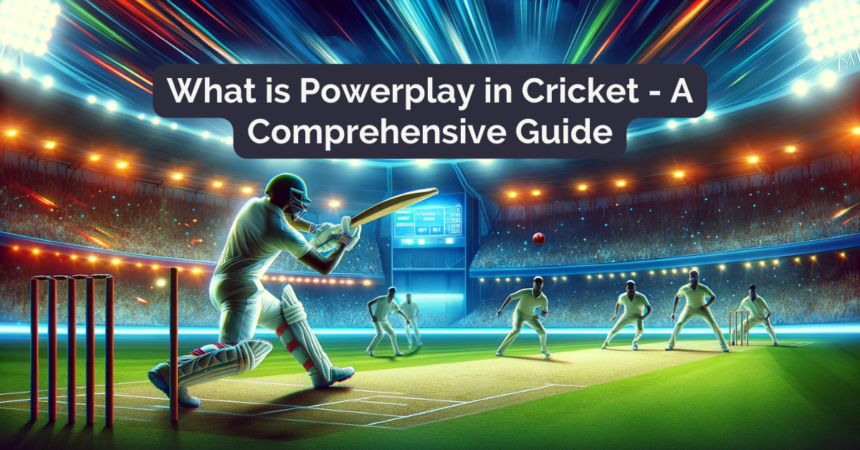Powerplay in cricket is a dynamic element in limited-overs cricket, particularly influential in One Day Internationals (ODIs) and Twenty20 (T20) formats.
This article explores the strategic nuances of powerplay in cricket, explaining its rules, impacts, and tactical uses in modern cricket.
Whether you’re a new fan or a seasoned follower, understanding powerplay can significantly enhance your appreciation of the game’s complexity and the decision-making involved.
What is Powerplay in Cricket?
Powerplay in cricket refers to a set of overs at the beginning of the innings where fielding restrictions are imposed, limiting the number of fielders allowed outside the 30-yard circle.
Originally introduced to add more excitement and runs to the game, powerplay periods are crucial for setting up the innings in both ODIs and T20 matches.
Evolution of Powerplay Rules in Cricket
The concept of powerplay in cricket has evolved significantly since its introduction. Initially, it only involved the first 15 overs of an ODI innings with severe restrictions on fielder placements.
Over time, to balance the contest between bat and ball and enhance strategic depth, the International Cricket Council (ICC) has adjusted these rules, including splitting powerplays into different phases throughout the innings.
Detailed Breakdown of ODI Powerplay Rules
In ODIs, the powerplay in cricket is divided into three phases:
- Powerplay 1 (Overs 1-10): Maximum two fielders allowed outside the 30-yard circle.
- Powerplay 2 (Overs 11-40): Four fielders allowed outside the circle.
- Powerplay 3 (Overs 41-50): Five fielders can be placed outside the circle, providing teams with an opportunity to accelerate the scoring rate or stem the flow of runs, depending on the match situation.
First Powerplay in Cricket
The first powerplay, spanning the first 10 overs of an inning, is a crucial period that often sets the tone for the entire batting effort.
During this phase, the batting team aims to capitalize on the field restrictions and score runs at a brisk pace, laying the foundation for a formidable total.
Batters must strike a delicate balance between aggression and caution, as losing early wickets can derail the team’s plans.
On the other hand, the bowling team seeks to maintain discipline and exploit any slightest mistake made by the batters, aiming to strike early and gain control of the match.
Read Also: What is a TFL in Football? Understanding Tackles for Loss
Batting Powerplay in Cricket
The batting powerplay in cricket is a strategic tool that allows the batting team to choose when they want to take advantage of the field restrictions.
This decision is often based on various factors, such as the match situation, the batting line-up, and the opposition’s bowling strengths.
Teams may opt for the batting powerplay when they have well-set batters at the crease, aiming to accelerate the scoring rate and put pressure on the bowling attack.
Alternatively, they may choose to take it later in the inning to provide a boost during the slog overs and push for a formidable total.
Bowling Powerplay in Cricket
The bowling powerplay presents a unique opportunity for the bowling team to apply pressure on the batting side.
By limiting the number of fielders outside the 30-yard circle, the bowlers can set more aggressive fields and challenge the batters with their variations and tactics.
However, the bowling powerplay is also a high-risk, high-reward strategy. If executed well, it can lead to crucial wickets and stifle the batting team’s momentum.
Conversely, if the bowling unit falters, it can result in a flurry of runs and shift the momentum firmly in the batting team’s favor.
Powerplay Rules in T20 Cricket
In T20 cricket, the powerplay is more condensed due to the shorter format.
The first six overs of an innings constitute the powerplay period, during which only two fielders are allowed outside the 30-yard circle.
This rule is designed to encourage aggressive batting in the early overs.
Strategic Importance of Powerplay in ODIs
Powerplay overs in ODIs set the tone for the innings.
A successful batting powerplay can provide a solid platform for a big total, while effective bowling during these overs can restrict the batting team’s score and build pressure.
Teams often strategize their best bowlers and most aggressive batsmen for these crucial overs.
Key Strategies During Powerplay Overs
During powerplay, teams strategize to maximize scoring opportunities while minimizing risks.
Batsmen aim to exploit the field restrictions by hitting over the infield, whereas bowlers focus on tight lines and lengths to force mistakes from the batsmen.
Role of Bowlers During Powerplay
Bowlers play a critical role during the powerplay, as their primary objective is to take early wickets and curb the run rate.
Fast bowlers often use swing and seam movement, while spinners might bowl with more flight and guile to deceive the batsmen.
Challenges and Opportunities for Batsmen
Batsmen face the challenge of scoring quickly while not losing wickets during powerplay.
This period offers a great opportunity to score runs due to the restricted field, but it also increases the risk of dismissals as batsmen take chances against tight bowling.
Notable Powerplay Performances in Cricket History
Several memorable powerplay performances have shaped match outcomes in international cricket.
Instances of explosive batting or exceptional bowling during these overs have often been pivotal, turning the momentum of matches.
Key Takeaways
- Understanding Powerplay: Grasping the rules and strategic use of powerplay is essential for appreciating modern limited-overs cricket.
- Strategic Application: Effective use of powerplay can influence the outcome of matches significantly.
- Evolving Rules: Powerplay rules have evolved and may continue to change as the ICC seeks to keep the game exciting and balanced.
- Impactful Performances: Successful exploitation or containment during powerplay overs can lead to memorable cricketing moments.
Conclusion
By comprehending the intricacies of powerplay in cricket, fans and players alike can gain deeper insights into the tactical layers that make cricket such a fascinating sport.




